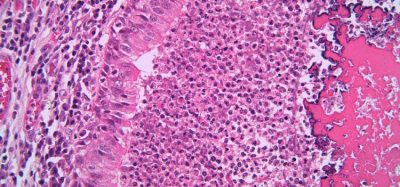Targeting tumours with novel radiopharmaceuticals
Posted: 19 October 2023 | Catherine Eckford (European Pharmaceutical Review), Dr Jack Hoppin (Ratio Therapeutics), Dr John Babich (Ratio Therapeutics) | No comments yet
In this exclusive Q&A, Dr Jack Hoppin, CEO, and Dr John Babich, Chief Scientific Officer of Ratio Therapeutics share their perspective on the evolving radiopharmaceutical landscape and why radiopharmaceutical therapeutics have significant potential in oncology.


The development of novel radiotherapeutics ushered in a new era in targeted treatment1 for cancer, with two separate radiotherapeutic approvals in Europe and the US, in 2018 and 2022. Recent advancements for radiopharmaceuticals in oncology include a $1.4 billion deal, in which Eli Lilly agreed to acquire two of POINT Biopharma Global’s late-stage radioligand therapies for oncological indications.
Additionally, in June 2023, the world’s largest radionuclide production facility of lutetium-177 opened in Germany. This milestone in the industry could potentially accelerate the development of radiopharmaceutical therapeutics.
In this exclusive discussion with EPR, Dr Jack Hoppin, CEO, and Dr John Babich, Chief Scientific Officer of Ratio Therapeutics share their perspective on the evolving radiopharmaceutical landscape, including the challenges of manufacturing these cancer treatments and why radiopharmaceutical therapeutics are so promising for this widespread disease.
How has the radiopharmaceuticals landscape evolved over the last several years?


Another area where radiopharmaceuticals have advanced, has been the development of highly specific, highly sensitive diagnostic imaging PET tracers, which have been used for neuroendocrine and prostate cancers. These diagnostics have significantly progressed based on rigorous Phase III trial designs and because of the impact these diagnostics have had on patient management. These diagnostics are also paired with therapeutics and act as an imaging biomarker to identify patients who may benefit from the paired therapies.
What is often overlooked when advancing radiopharmaceuticals in terms of development and advancement?
One of the aspects of radiopharmaceuticals that is often overlooked is how complicated it is to develop a new agent, in terms of the complexity of drug design to realise a therapeutic candidate and the implementation of the clinical evaluations. There have been many cases where people have tried to simply link existing drugs to radioisotopes or have attached new (recently made in scale) radioisotopes on old drugs. This is not an effective strategy. Although a target may be imaged with a radioactive imaging agent, it does not necessarily translate into a therapeutic candidate. It is important to start with an effective molecule and then choose the isotope based on the performance of this molecule.
What is the main challenge in manufacturing alpha therapy radiopharmaceuticals? What is the most promising solution?
The biggest challenge with alpha particles is that they are inherently damaging to chemical structure, which is what makes them so effective at killing cells. With alpha particles, you must be very careful how the drug is made to ensure that the compound remains stable between manufacturing and use. One has to sensibly determine how to attach an alpha particle to a molecule, when to attach it and how to formulate it so that the compound can be shipped and arrive at a specific destination for use in the patient with all purity specifications unchanged. Manufacturing the drug locally and therefore limiting the amount of time spent in transit is one of the ways of dealing with this challenge.
What is the biggest way technology advancement is contributing to the development of radiopharmaceuticals?
A big technological advancement is being able to design machines that can make radioisotopes in sufficient quantity to advance the way we can manufacture radiopharmaceuticals”
A big technological advancement is being able to design machines that can make radioisotopes in sufficient quantity to advance the way we can manufacture radiopharmaceuticals. We are hoping that advancements in particle acceleration will make isotopes readily available and will also bring down costs to further facilitate the feasibility of local radiopharmaceutical manufacturing.
Can you share an update on the clinical trial for your lead candidate?
We recently announced in collaboration with Lantheus and PharmaLogic, the first patient dosed in a Phase I study evaluating a fibroblast activation protein (FAP)-targeted PET diagnostic compound (RTX-1363S) for a broad array of epithelial-derived cancers. FAP is expressed in cancer-associated fibroblasts across nearly all epithelial-derived cancers, which includes breast, pancreatic, and gastrointestinal cancers. Additionally, we are developing a novel therapeutic candidate which is a companion to RTX-1363S, designed to treat these cancers, anticipated to enter the clinic early next year.
We are also currently developing a Granzyme B-targeted agent for PET imaging applications that was in-licensed from Merck. Granzyme B is an enzyme released by activated immune cells and using this as a in vivo imaging biomarker has great potential to monitor immune cell activation in a variety of inflammatory diseases, autoimmune diseases, cancer and infections.
How do you perceive radiopharmaceuticals complementing existing cancer treatments, such as chemotherapy and immunotherapy?
we must prove the effectiveness of radiopharmaceuticals through clinical trials… This has been demonstrated recently with PLUVICTO… the first US Food and Drug Administration (FDA)-approved targeted radioligand therapy for eligible patients with prostate cancer”
At this moment, there is no single treatment for cancer today. Investigations are currently ongoing to demonstrate that radiopharmaceuticals have value, both as single agents and in combination with other therapies. Like other cancer treatments, we must prove the effectiveness of radiopharmaceuticals through clinical trials, so they are more available and eventually implemented as a common standard of treatment to control tumours. This has been demonstrated recently with PLUVICTO®, which was the first US Food and Drug Administration (FDA)-approved targeted radioligand therapy for eligible patients with prostate cancer.
There is great hope of this class of drug specifically to work in conjunction with immunotherapeutics, given the lack of toxicity of radiopharmaceuticals in general compared to most chemotherapies.
What do you envision the future of radiopharmaceuticals to be like? How could this impact the pharmaceutical industry as a whole?
One aspect that is extremely promising about radiopharmaceutical therapeutics is that they do not give a patient the side effects that are commonly experienced with chemotherapy. Rather than affecting the body systemically, radiopharmaceuticals are designed to only target the tumour which subsequently limits off target toxicity to other areas in the body and thus, reduces unwanted side effects. As a result, we envision that radiopharmaceuticals will eventually be incorporated into current cancer treatment paradigms’ due to its application in combination with other therapies.
About the interviewees


Following his graduate studies, Dr Hoppin was an Alexander von Humboldt Fellow at the Research Center Jülich, Center for Electronics in Germany from 2003 to 2005. Following his position in Jülich, he took his first position in industry serving as the Project Manager and ultimately the Vice President of Imaging Systems for Bioscan, Inc. During this time he managed the development, launch and commercialization of the NanoSPECT/CT system. This imaging system won multiple innovations awards and ultimately generated over $100 million in revenue.
Dr Hoppin began working with Dr John Babich and Noria Therapeutics in 2018, joining their board of directors in 2019 and supporting the subsequent creation and funding of subsidiary PSMA Therapeutics. Hoppin served as lead director of Noria as the two organisations were sold to Bayer Healthcare in June of 2021.


In 1998, John co-founded and was President and Chief Scientific Officer at Molecular Insight Pharmaceuticals (MIP) in Cambridge, US. At MIP he brought six new radiopharmaceuticals to the clinic including the world’s first technetium-99m labeled PSMA inhibitor for imaging prostate cancer which is currently in a Phase III clinical trial. His team also introduced the first therapeutic small molecule inhibitor of PSMA for targeted radiotherapy of metastatic prostate cancer in collaboration with Heidelberg University, which is now in late stage clinical trials in the US. He also oversaw the development of Azedra™ a targeted radiotherapeutic recently approved by the US FDA for the treatment of rare tumours of the adrenal gland.
In 2013 he joined the faculty at Weill Cornell Medical College where he was Professor of Radiopharmaceutical Sciences in Radiology and Chief of the Division of Radiopharmaceutical Sciences in Radiology and Head of PET Radiochemistry at The Citigroup Biomedical Imaging Center. His research lab focused on second generation targeted radiotherapeutics which became the core technology of Noria Therapeutics, a company he started in 2017.
References
- Meeting rising demands of a new radiotheranostic era. [Internet] Jaafar-Thiel, L. 2023. [cited 2023Oct]. Available from: https://www.europeanpharmaceuticalreview.com/article/186284/meeting-rising-demands-of-a-new-radiotheranostic-era/
Related topics
Anti-Cancer Therapeutics, Biopharmaceuticals, Clinical Development, Clinical Trials, Drug Development, Drug Manufacturing, Immunotherapy, Manufacturing, Therapeutics
Related organisations
Related drugs
Related diseases & conditions
Autoimmune diseases, Breast cancer, Cancer, gastrointestinal cancer, infectious diseases, Neuroendocrine tumours (NETs), Pancreatic Cancer, Prostate cancer









